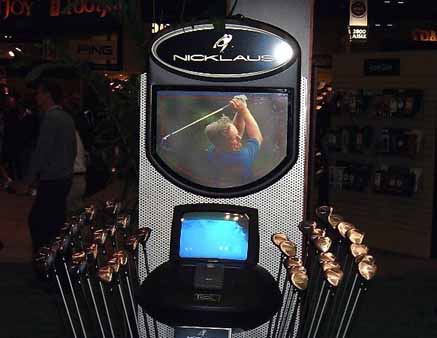Freezing out the competition
The New Cryogenic Irons from Nicklaus Golf
_1.jpg?width=1600&aspect_ratio=16:9)
Of all the new irons and woods shown at the PGA Merchandising show in Orlando, the new irons from Nicklaus golf have endured the worst possible birth pains, becoming submerged in -300 degree temperatures and then reheated to arrive at the finished result, Cryogenic Supersteel.
The new Nicklaus VCG irons and Airmax Woods have been two years in development and Nicklaus Golf are the only company to use Cryogenic, or Nitrogen gas freezing techniques to bring a golf club to our Pro shops.
Amy Walker, Marketing Manager of Nicklaus Golf explained the process in detail.
"We had a look at various types of steel to make a responsive set of irons from. We wanted to improve the qualities of steel, but not make it unaffordable. So the designers had the brief of "affordable performance".
"Cryogenic technology was developed by scientists and metallurgists in conjunction with NASA for use in the extreme temperatures in Space. One of the advantages of using cryogenic steel for golf clubs is that it realigns the molecular structure of steel, hardening it and altering the performance characteristics of the club". Said Walker.
"With the VCG Irons, the metal is placed in a Nitrogen gas filled chamber and frozen to minus 300 degrees using 'Deep Cryogenic Tempering' or DCT and after 24 hours, the metal is reheated. This kind of metallurgy is ideal for metals that will undergo any kind of force or pressure, ideal for golf clubs".
What happens with cryogenic freezing is the molecular structure of ordinary steel radically changes when the carbon molecules become smaller and harder into a solid, more uniformed pattern.
And throughout this whole process, the clubhead looks exactly the same.
"But", she continued, "it is altered to the extent that it allowed our designers to use thinner club faces which in turn improved the transfer of energy at impact, adding distance to each shot and also allowing the distribution of weight to where it is needed most on each iron.
"For the woods, it allows them to become oversize without using Titanium, but still receive the same benefits of an oversize club, forgiveness".
Slowly you begin to get the picture that some of the most modern technology is used to improve your scoring on the golf course. But there is even more to the new Cryogenic family of Woods and irons…the Cantilever weight System.
Bill Henwood, Chief Sales and marketing Officer for Nicklaus Golf explains.
"The Cantilever Weight system allows us to move the weight away from the face and lower the centre of gravity to help the ball airborne and it naturally square the face at impact.
"The weight that was formerly in the face has been redistributed to the perimeter which allows golfers to square the clubface easier, no matter what club they are using adding extra control and forgiveness on mis-hits".
"The weight is moved away from the club and moved progressively forward in the set. On the long irons, the weight is placed near the heel allowing the clubface to close faster. In the mid-irons, the weight is moved towards the centre and in the short irons, towards the toe. The primary advantage of this is that the Cantilevered Weight System closes the face for you so you don't have to swing faster to square the face up".
The same technology is used in both the irons and the Woods and you would think that with this space age technology there is a price tag to match. But Nicklaus have succeeded in their quest for "affordable performance" and the irons, available this summer will retail at around £499 for the steel shafted version and £699 for graphite shafts.
The Airmax Woods, already available in the USA are currently retailing at $199 each with graphite shafts and there will be a selection of fairway and utility Woods at the same price. At the time of going to press, Nicklaus golf had no prices for the Woods for the UK Market.
_3.jpg?width=1600)
_2.jpg?width=1600)